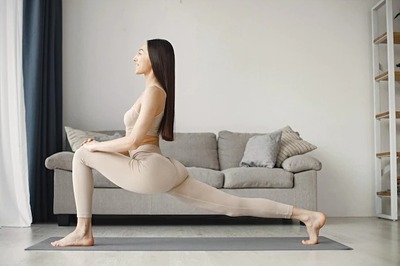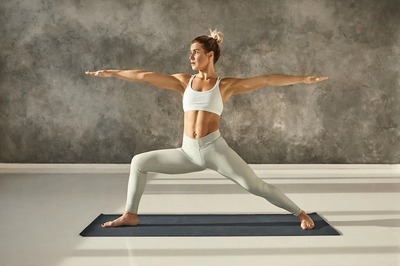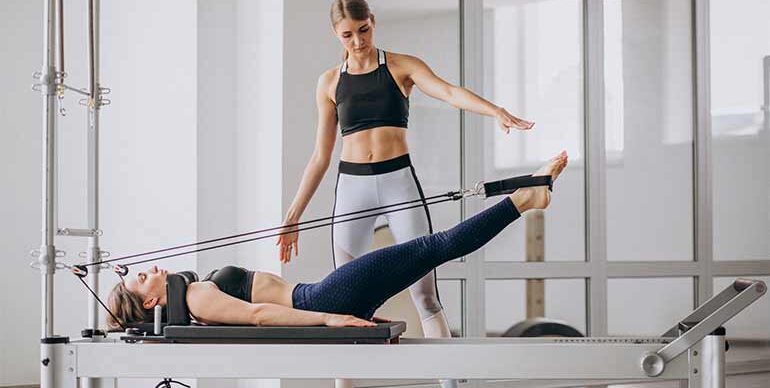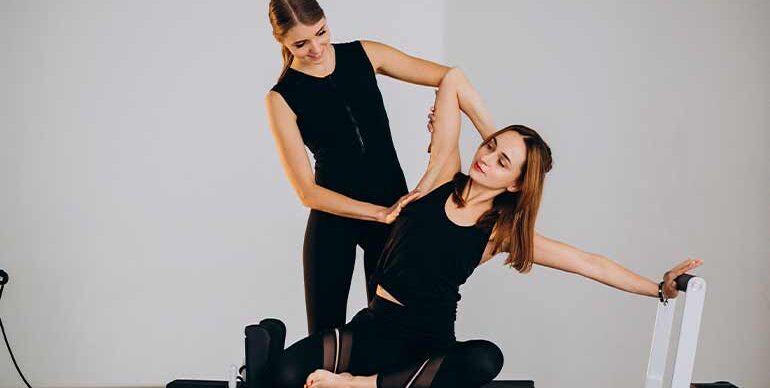
Instead of forcing the muscles to tear and rebuild into the shorter and thicker shape that conventional strength training does, the Pilates movements stretch and pull the muscles into a longer and leaner shape.
Pilates works your entire body in a methodical manner, strengthening both your strong and weak muscle groups. It promotes body balance, focuses on problem areas, and works to build both strength and flexibility.
When Joseph Pilates created the first matwork exercises, he wanted to fully extend the body to benefit the exerciser as much as possible. Even seasoned athletes could struggle with some of his creative movements. This is a result of the usage of muscle control and coordination that are uncommon.
Numerous Advantages
The Pilates method works the entire body and aims to synchronize the body’s upper and lower muscle groups with its core.
The impact on strength, flexibility, posture, and coordination is significant. Pilates will strengthen your body while also focusing your mind, whether you are interested in it for aesthetic, medical, or preventative purposes. Anyone can complete it.
Pilates can be practiced by those who are not athletes. The workouts also attempt to test the body’s capabilities while minimizing the amount of strain placed on it.
This implies that Pilates can be performed by people of any age and fitness level. You will profit from it whether you are young or elderly, an avid exerciser or someone who has never done it before.

Basic Apparatus
Pilates exercises don’t require any pricey equipment; all you need is a floor mat to follow a program at home. The Pilates method is frequently associated with a variety of cutting-edge Pilates apparatus, which can play a crucial role in the exercises.
Keep in mind, too, that nothing you can accomplish on a machine that you can’t do on a mat.
Increase Concentration
With Pilates, which is hailed as the “intelligent way to exercise,” the emphasis is on concentration and self-control. Normal exercise routines typically don’t call for mental discipline, but Pilates is different since it heals and treats the mind and body on various levels. Additionally, because yoga strengthens every muscle in the body, routine daily activities like grocery shopping and gardening become safer and easier.
Pilates and yoga
Yoga and Pilates share several objectives. Most importantly, they both support personal growth in a non-competitive environment. Additionally, the workouts place equal emphasis on muscular strengthening and flexibility. Deep breathing and the use of smooth, lengthy motions that enable muscles to relax and lengthen are key components of both yoga and pilates.
Due to the increased flexibility, it fosters in the body, Pilates is comparable to yoga. The distinction is that Pilates moves through a series of motions that are more dynamic, methodical, and anatomically grounded, whereas certain Yoga techniques include shifting from one static posture to the next without repeats.
Popular Backing
Although Pilates has been around since the 1920s, awareness of this fitness regimen that improves your strength and the immune system has only recently gained popularity. Sharon Stone, Courtney Cox Arquette, Minnie Driver, Julia Roberts, and Madonna (who even asserted that it is the only way to exercise) are just a few of the Hollywood luminaries who have embraced the method. Pilates is now widely available in gyms and health clubs and is no longer just for the wealthy and famous.
Integrated Program
Pilates is a method of movement that requires conscious thought and a genuine commitment to your body and wellbeing.
Exercise shouldn’t be treated as a separate activity in your life.
When Pilates is used in conjunction with enough sound sleep, a balanced diet, and an additional workout program, its effectiveness increases noticeably. Therefore, Pilates provides a priceless, reliable foundation for whatever other consistent activity you engage in. It is now widely acknowledged that several exercise regimens—including bodybuilding, swimming, aerobics, and gym work—are neither unsuitable nor sufficient.
An uneven exercise program won’t get the body ready for everything.
Although injuries are less common in workout programs in gyms due to comprehensive warming-up procedures and health and safety standards, pulling muscles when moving heavy objects at home or at the office still happens frequently. Pilates provides a method of teaching the various body parts to cooperate, support one another, and provide your body with the necessary defense. This is what we need to adopt. It is now widely acknowledged that several exercise regimens—including bodybuilding, swimming, aerobics, and gym work—are neither unsuitable nor sufficient.

Cross-training
You don’t have to stop participating in other sports and fitness regimens just because you’ve started exercising utilizing the Pilates approach. On the contrary, adding cardiovascular activity to your Pilates routine would benefit it more.
Combine aerobic activities with low-stress Pilates moves. Pilates will fix any posture issues brought on by other forms of repetitive exercise, making it the perfect cross-training activity. Strength, flexibility, motor skills, coordination, and relaxation are all included in the Pilates method of exercise. improper, but just not enough.
The Exercise
What do you hope to get out of this exercise? You must be aware of your physical strengths and weaknesses in order to concentrate on workouts that will be most helpful to you.
Weaknesses relate to tight portions of your body that prevent you from properly completing a task as well as to a lack of muscular strength. Keep in mind that a rigid body will have the same issues as one with weak muscles.
You’ll discover that the workouts you dislike the least are typically the ones your body needs more practice with. Similar to how those who are simpler would require less practice.
Pure Pilates
Although the fundamentals of Joseph Pilates’ approach were always the same, he tailored the routines when working with different pupils in order to meet their needs. Joseph Pilates developed his technique out of instinct.
Understanding what you cannot achieve is, therefore, a crucial component of Pilates.
Always pay attention to any weak spots and pay attention to your body, both during and after exercise.
Taking it Slow
It’s not a good idea to start a Pilates program with advanced techniques. The original Pilates exercises are difficult and not suitable for people who are not familiar with the proper form. You run the danger of harm if you push yourself to perform Pilates movements that are difficult or uncomfortable. You can therefore advance toward your ultimate goals at an efficient rate if you maintain a sensitive awareness of your body and gradually challenge yourself.
The exercises mentioned here are beginner-level, but as you gain strength, you can perform the intermediate variations.

Push Yourself
Keep in mind that working across the entire spectrum of body movements requires balancing strength and mobility on an ongoing basis. However, a good method to start pushing yourself is to start with flexibility and gentle strength workouts.
This is crucial to do in order to have your body ready and ready for the more difficult Pilates moves.
Pain Prevention
Minor aches and pains can be a sign of physical strains and pressures, even in the healthiest of people. Never dismiss these symptoms; instead, use them to determine whether muscles need more stretching and mobility or more strengthening.
Pilates teaches the body to move with proper posture and to avoid injuries. You must achieve a proper muscle balance in order to have excellent posture.
Indeed, poor posture or muscular imbalances are frequently somehow connected to injuries. There are numerous causes for these kinds of issues.
One cause could be repetitive motions, like when a golfer trains their swing on one side of the body repeatedly or when someone works at a desk for extended periods of time.
In fact, any pattern that upsets the natural equilibrium of your body and causes it to become tense can cause weakness, tightness, and an increased risk of injury.
Pain and Gain
During training, there is always some degree of soreness, particularly when extending muscles that you may not have used recently. You might feel some pain after a vigorous stretch, but be careful not to strain yourself. Any abrupt or sharp pain must be stopped right away. Never should one go to this extreme. Once more, it needs to be kept in mind that Pilates should be practiced progressively. It is always preferable to increase gradually. You can only attain a balance between achievement and challenge in this way. Never work out if you have a persistent ache or if any of your muscles are inflamed.

The Bottom Line
Pilates has several benefits for your exercise program, from improved posture to enhanced strength. Numerous specialized studios, as well as gyms and community centers, provide Pilates classes. It’s advised to start your training with live Pilates instruction at a studio or gym, preferably from a certified Pilates instructor, so the accessibility is good for beginners.
You can always use streaming videos, Pilates–specific apps, and sample workout routines to augment your learning. Pilates can even be practiced at home. You only need a mat and comfy clothing; no special equipment is required.
Do not miss a single article!
Submit your email id to get new articles directly into your email inbox!
- Why You Should Learn Pilates - August 27, 2022
- All You Need to Know about HIIT Workouts - August 23, 2022
- Hallmarks of A Good Fitness Trainer - August 20, 2022


Add Review